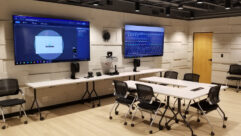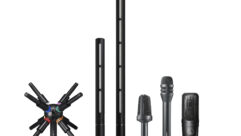
Audio-Technica ATCS-60 Conference System Review
Mar 14, 2013 3:09 PM,
Reviewer: John McJunkin
An infrared system for secure conferencing.

People have asked me what kind of clients would request that I specify a secure conferencing system. A light bulb comes on when I tell them that secure conferencing is necessary for government and military applications, but they also understand that financial market and business applications could require a secure means by which boardroom or delegate-type discussion can be conducted. Industrial espionage is a very real phenomenon, and security breaches could cost a company millions of dollars in sales. There are more than a few mechanisms available to facilitate secure conferencing, including various encryption techniques and frequency-scrambling schemes. They can be very good, but RF systems are always susceptible to interception and potential de-encryption since the signal passes through the walls of a building.
One solution is to move the signals on a carrier wave composed of light, and infrared systems have emerged as a solution. The notion is that light can be prevented from leaving the building, which effectively makes capturing any of the communication impossible. It’s a favorite of many in government settings where very high security is necessary. Audio-Technica’s ATCS-60 is an infrared system, and I evaluated one recently. It consisted of an ATCS-C60 master control unit, five ATCS-M60 delegate units with microphones, an ATCS-D60 distributor, two ATCS-A60 IR transmitter/receiver units, an ATCS-B60 battery charger, five LI-240 lithium-ion batteries, and all necessary cabling and power supplies.
The nerve center of the system is the ATCS-C60 master control unit. It’s housed in a 2RU enclosure that can indeed be rackmounted or used tabletop. Its front panel, from left to right, features a power switch, LEDs to indicate which channels are active, when data are received from delegate units, and when the unit is connected to a computer. There is a slider switch that toggles the unit from auto to manual mode, and barrel-type rotary switches that determine voice detection threshold, hold time, and a test mode. Two additional barrel-type rotary switches determine the maximum number of simultaneous speakers from one to five and the number of priority units from zero to four. A “set” pushbutton executes the settings established by the aforementioned switches. There is a seven-LED level meter, with a slider switch that toggles between input and output monitoring. A Plexiglas panel can be screwed to the front of the unit to cover the switches and prevent unauthorized changes. The rear panel features all the unit’s I/O and a handful of controls. There are BNC jacks for connection to as many as four ATCS-A60 IR transceivers, five 1/4in. jacks representing direct outputs for channels A – E, four RCA jacks representing monitor inputs, typically used for translation. There are also four knobs determining monitor levels, slide switches determining monitor mode, and whether the unit’s two RCA record inputs are to be blended in with the monitor inputs. An additional RCA jack facilitates an auxiliary input, and has a level knob associated with it. An XLR input with a level knob is situated just above an XLR output, also with its own level knob, and an RCA jack presenting the same output. At the far right of the rear panel is an IEC AC power inlet. The unit can be connected to a computer with a D-sub 9-pin connector via the RS-232C data transfer protocol. This is one minor criticism I have with the system. To say that RS-232C is old is an understatement (RS-232 was introduced in 1962 and the C revision in 1969). Modern audio technology ought to offer at minimum an Ethernet socket to connect with a computer, if not USB. I bet future revisions of this system will feature one or both of these.
The ATCS-M60 delegate unit is the tabletop box associated with the system. It’s housed in an aesthetically pleasing wedge-shaped enclosure that slopes up from the user-facing front side toward the rear, where there is a curved cylinder-shaped section housing the unit’s IR emitters and receivers. Near the highest part of that wedge is its proprietary 4-pin mic jack, along with a red LED to indicate power. The available gooseneck mics (one short, one long) feature an LED ring just below the mic capsule to indicate operational and battery charge status. Below that is a green LED to indicate talk mode, and the unit’s talk pushbutton. On the right side of the enclosure are a recessed thumbwheel volume control, a monitor selector switch, an earphone jack, a 9-pin I/O socket, and power switch. On the bottom of the unit is a battery slot along with a slider switch determining transmission power, and switches determining unit ID. There is an inlet for DC power inside the battery slot as well.
If more than four IR transceivers are necessary, the system requires a signal splitter known as the ATCS-D60 distributor to handle I/O for the infrared signal—a very simple little black box that a little more than 2in. square with a single BNC jack on one side and two BNC jacks on the other. Otherwise, up to four IR transceivers can be connected without splitters. The unit’s actual IR transmitter/receivers are roughly 4in. in diameter and 2.5in. tall. Each has a BNC jack in the center on the bottom. The ATCS-B60 charger for the delegate unit batteries is a shoebox-sized unit with 10 slots in its top panel to accommodate batteries, and a power switch and 4-pin DC power inlet on one end.
Setup of the system for real-world use was very easy. I connected mics to the five delegate units I’d been sent, then slid a battery into the slot of each, and they were ready to go. I connected the distributor to the first infrared BNC jack on the master control unit. I then connected the transmitter/receiver to the distributor as well. I turned on the master control unit, and confirmed that it was in manual mode. The system was immediately ready for operation. The front-panel controls of the ATCS-C60 made it easy to set the number of people who were allowed to speak simultaneously, along with priority operation. The microphone set as ID001 was the chairperson mic, and the chairman in our evaluation meeting was able to lock out the other units by simply holding down his button.
I also switched the system over to automatic operation, in which the mics are speech activated and will actually delay the signal for the briefest of moments to ensure that the very beginning of the very first syllable is heard. The system will wait for a pause in speech, and then return the signal to precise, realtime operation. Although I did not use the interpretation capacity of the system, it’s also easily set up, with essentially an I/O loop feeding from the control unit out to the interpreter booth(s) and then back. I recorded the meeting and found the quality of the recording to be more than adequate for production of a podcast.
The system can be as simple or as sophisticated as necessary to accomplish the requirements of the application. Once the contractor handles the fundamental set up, the day-to-day deployment of the system by non-professionals is very simple. The most technophobic receptionist in the world can easily administer the charging and insertion of batteries, placement of units, and switching the configured system on. Once those things are done, the system will work reliably and consistently. Additional control can be achieved by connecting the control unit to a computer, which adds again to the sophistication it can achieve. The system’s audio bandwidth does not extend from 20Hz to 20kHz (and Audio-Technica does not claim so). It does, however, provide a spectrum that starts well below the typical frequency of the human voice and ends well above. Because it’s transmitted via infrared and hence virtually impervious to RF interference, it’s very clean and quiet, providing more than necessary intelligibility for conferencing purposes. The system is a bit spendy by comparison, but the virtual elimination of RF interference, practically impenetrable security, and ease of use make it a good value and well worth consideration.
PRODUCT SUMMARY
Pros: Robust, secure conference solution, intelligible audio, ease of deployment
Cons: No connection with computer via modern data protocols, substantial price
Applications: Delegate-oriented conferencing with critical security requirements
Price: $5,200(ATCS-C60 master control unit); $1,300 (ATCS-M60 delegate unit, base unit); $180 (ATCS-60MIC dedicated gooseneck microphone, standard); $200 (ATCS-L60MIC dedicated microphone, long); $1,050 (ATCS-A60 IR transmitter/receiver); $260 (ATCS-D60 distributor, splitter); $1,360 (ATCS-B60 battery charger); $50 (DMQ-60 monaural earphone); $190 (LI-240 Lithium-ion battery)
SPECIFICATIONS
ATCS-C60 master control unit
Carrier frequency band: 1MHz – 10MHz
Modulation method: Frequency modulation
Infrared data format: 9600 bps GMSK system
Inputs:
Monitor Inputs (Ch. 1-4): -10dBV unbalanced pin jack
Auxiliary Input 1: -10dBV unbalanced pin jack
Auxiliary Input 2: -10dBV balanced pin jack SLR-3P/-50dBV; -10dBV unbalanced 6.3mm standard jack
Outputs:
Direct Output (A – E): -10dBV unbalanced 6.3mm standard jack
Output 1: -10dBV unbalanced pin jack
Output 2: -10dBV balanced XLR-3P (male)
Record Output 1 and 2: -10dBV unbalanced pin jack
Maximum IR transmitter/receivers: Four (sixteen when ATCS-D60 is used)
External control terminal: 9-pin D-sub (RS-232C)
Input Level:
Monitor inputs (Ch. 1-4): Gain +6dB to -∞
Auxiliary input 1: Gain +40dB to -5dB
Auxiliary input 2: Gain +6dB to -∞
Output level:
Output 1: Gain +6dB to -∞
Output 2: Gain +6dB to -∞
Power supply: 100 – 240VAC, 50/60Hz, 75W
Dimensions: 431mm x 274mm x 88mm (WxDxH)
Weight: 4.2kg
ATCS-A60 IR Transmitter/Receiver Unit
Carrier frequency band: 1MHz – 10MHz
IR wavelength: 870nm
Modulation method: Frequency modulation
Operating distance: Approximately 5M (normal mode); approximately 4M (lo mode)
Connection terminal: BNC jack
Dimensions: 108mm x 55.5mm (Diameter x Height)
Weight: 151g
ATCS-M60 Microphone Unit
Carrier Frequency Band: 1MHz – 10MHz
IR Wavelength: 870nm
Modulation Method: Frequency Modulation
Operating Distance: Approximately 5M (normal mode); approximately 4M (lo mode)
Input (Microphone Terminal): XLR-4P
Output:
Monitor Loudspeaker: Maximum level 2W @ 8Ω
Headphone Output: 3.5mm monaural mini jack
External Control Terminal: MIN-DIN connector 9P (female)
Power Supply: Dedicated lithium ion battery – 7.4VDC, 2400mAh or 12V, 1A A adaptor
Battery Life: Can vary with loudspeaker volume, operating time, and charge condition of battery; approximately 8 hours (normal mode, transmission to reception ratio 1:4); approximately 9 hours (lo mode, transmission to reception ratio 1:4)
Dimensions: 187mm x 149mm x 75.5mm (WxDxH)
Weight: 600g (excluding microphone or battery)
John McJunkin is the principal of Avalon Podcasting in Chandler, Ariz., and produces and co-hosts a top-rated morning radio talk show in Phoenix. He has consulted in the development of studios and installations and provides high-quality podcast and voice production services.









